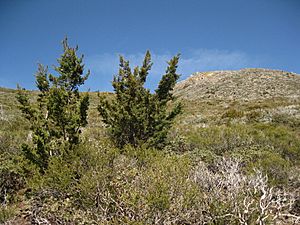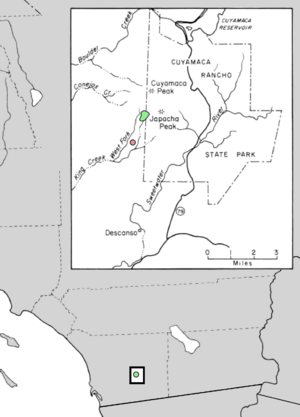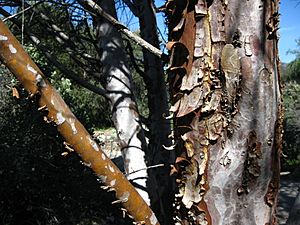Cupressus stephensonii facts for kids
Quick facts for kids Cupressus stephensonii |
|
|---|---|
 |
|
| Conservation status | |
| Scientific classification | |
| Genus: |
Cupressus
|
| Species: |
stephensonii
|
 |
|
| Natural range of Cupressus stephensonii | |
| Synonyms | |
|
Hesperocyparis stephensonii (C. B. Wolf) Bartel;. . Callitropsis stephensonii (C.B.Wolf) D.P.Little |
|
The Cupressus stephensonii is a special type of tree known as the Cuyamaca cypress. It is found only in southern California, meaning it is endemic to that area. This tree has also been called Hesperocyparis stephensonii. In the past, it was sometimes listed as a subspecies or variety of the Arizona cypress.
Contents
Where Does the Cuyamaca Cypress Live?
The Cuyamaca cypress grows only in a very small area. You can find it near the start of King Creek. This area is in the Cuyamaca Mountains in San Diego County. It is located south of Cuyamaca Peak in extreme Southern California.
Most of these trees grow at elevations between 4,500 and 5,100 feet (about 1,370 to 1,550 meters). They are found within a special protected area called the King Creek Research Natural Area. This area is part of the Cleveland National Forest.
Why Is This Tree Important to Protect?
The Cuyamaca cypress is a Critically endangered species. This means it is at a very high risk of disappearing forever. The IUCN Red List and the California Native Plant Society both list it as seriously endangered.
In 2003, a large wildfire called the Cedar Fire burned through its habitat. This fire greatly reduced the number of trees. After the fire, only about 30 to 40 individual trees were left in the entire world. This makes every single tree very important for the survival of the species.
What Does the Cuyamaca Cypress Look Like?
The Cuyamaca cypress can grow to be about 33 to 52 feet (10 to 16 meters) tall. It usually grows into a wide, spreading tree. It often looks almost as wide as it is tall, with a main stem in the middle.
The female cones are about 10 millimeters (less than half an inch) across. They usually have 6 to 8 scales, most often 6. These scales often have small, pointed bumps called umbos. Each cone can hold about 100 to 125 seeds. Unlike many other cypress trees, the Cuyamaca cypress releases its pollen during the summer.
Different Names for the Cuyamaca Cypress
Scientists sometimes use different names for the same plant. The name Hesperocyparis stephensonii has been used more often since 2010. This name is used by groups like the USDA and the California Native Plant Society.
The genus Hesperocyparis includes cypress species from the New World (like North America). The genus Cupressus now mostly includes species from the Old World (like Europe and Asia).
The Cuyamaca cypress has also been called a subspecies or variety of the Arizona cypress (''Cupressus arizonica''). It can be tricky to tell them apart. One way is to look at the smooth bark on older trees. Its bark can be pink, gray, or even pure white. Also, the Cuyamaca cypress tends to spread out more than the Arizona cypress. Scientists are still studying these trees to understand their exact family relationships.
See also
 In Spanish: Cupressus stephensonii para niños
In Spanish: Cupressus stephensonii para niños



